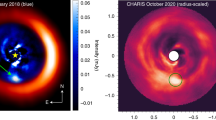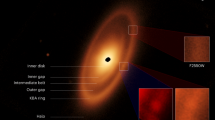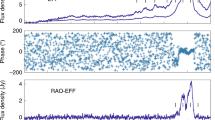Abstract
The apparent closest approach of the star SAO186001 to Neptune was observed photoelectrically on 22 July 1984 at Cerro Tololo Inter-American Observatory. A 32% signal drop lasting about 1.2 s was probably caused by a partially transparent arc of material at a distance of 67,000 km from Neptune. Neptune's arc(s) do not vary smoothly with azimuth, unlike the rings of other jovian planets.
This is a preview of subscription content, access via your institution
Access options
Subscribe to this journal
Receive 51 print issues and online access
$199.00 per year
only $3.90 per issue
Buy this article
- Purchase on Springer Link
- Instant access to full article PDF
Prices may be subject to local taxes which are calculated during checkout
Similar content being viewed by others
References
Sicardy, B. et al. Nature (submitted).
Mink, D. J., Klemola, A. R. & Elliot, J. L. Astr. J. 86, 135–137 (1981).
Hubbard, W. B. et al. Bull. Am. astr. Soc. 13, 728 (1981).
Hubbard, W. B. et al. Astr. J. 90, 655–667 (1985).
Sicardy, B. et al. Bull. Am. astr. Soc. 15, 816 (1983).
Elliot, J. L. et al. Nature 294, 526–529 (1981).
Reitsema, H. J., Hubbard, W. B., Lebofsky, L. A. & Tholen, D. J. Science 215, 289–291 (1982).
Elliot, J. L. et al. Astr. J. 90, 2615–2623 (1985).
Vilas, F. & Hubbard, W. B. Bull. Am. astr. Soc. 17, 923 (1985).
IAU Circ. No. 3962 (1984).
IAU Circ. No. 3968 (1984).
IAU Circ. No. 4022 (1984).
Roques, F. et al. Bull. Am. astr. Soc. 16, 1027–1028 (1985).
Hubbard, W. B. et al. Lunar planet. Sci. 16, 368–369 (1985).
Maddox, J. Nature 318, 505 (1985).
Elliot, J. L., Wasserman, L. H., Ververka, J. & Sagan, C. Astrophys. J. 190, 719–729 (1974).
Hubbard, W. B. & Zellner, B. H. Astr. J. 85, 1663–1669 (1980).
Elliot, J. L., French, R. G., Meech, K. J. & Elias, J. H. Astr. J. 89, 1587–1603 (1984).
Nicholson, P. D., Matthews, K. & Goldreich, P. Astr. J. 87, 433–447 (1982).
Hubbard, W. B. Science (in the press).
Cuzzi, J. N. et al. Planetary Rings (eds Greenberg, R. & Brahic, A.) (University of Arizona Press, 1984).
Elliot, J. L. & Nicholson, P. D. in Planetary Rings (eds Greenberg, R. & Brahic, A.) (University of Arizona Press, 1984).
Lissauer, J. J. Nature 318, 544–545 (1985).
Dermott, S. F. & Murray, C. D. Icarus 48, 1–11 (1981).
Froeschlé, C. & Scholl, H. Astron. Astrophys. (submitted).
Harris, A. W. NASA Conf. Publ. 2330 357–373 (1984).
Sicardy, B. et al. Bull. Am. astr. Soc. 17, 923–924 (1985).
Author information
Authors and Affiliations
Rights and permissions
About this article
Cite this article
Hubbard, W., Brahic, A., Sicardy, B. et al. Occultation detection of a neptunian ring-like arc. Nature 319, 636–640 (1986). https://doi.org/10.1038/319636a0
Received:
Accepted:
Issue Date:
DOI: https://doi.org/10.1038/319636a0
This article is cited by
-
Circumplanetary Dust Populations
Space Science Reviews (2019)
-
The size, shape, density and ring of the dwarf planet Haumea from a stellar occultation
Nature (2017)
-
Ring in the new
Nature (2014)
-
Exploration of the Outer Solar System by Stellar Occultations
Earth, Moon, and Planets (2009)
-
Dynamics and Composition of Rings
Space Science Reviews (2005)
Comments
By submitting a comment you agree to abide by our Terms and Community Guidelines. If you find something abusive or that does not comply with our terms or guidelines please flag it as inappropriate.



